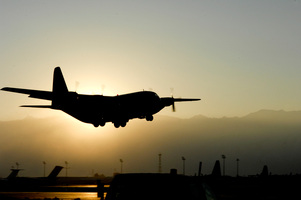 | Back to e-WV
| Back to e-WV
 The West Virginia Encyclopedia
The West Virginia Encyclopedia
 | Back to e-WV
| Back to e-WV
 The West Virginia Encyclopedia
The West Virginia Encyclopedia

The September 11, 2001, attack on the World Trade Center in New York and the Pentagon in Washington resulted in nearly 3,000 deaths. The attacks were attributed to the international terrorist organization, al-Qaeda. Al-Qaeda’s leader, Osama bin Laden, and a cadre of his followers had been given sanctuary by the Taliban leaders of Afghanistan.
President George W. Bush authorized military action to destroy terrorist bases in Afghanistan and the government that had allowed them. The United States, along with the United Kingdom, Australia, and a “Northern Alliance” of Afghans, launched an attack on October 7, 2001, and quickly drove the Taliban from power. Al-Qaeda training camps were destroyed and the terrorists driven into hiding or into neighboring Pakistan. The initial coalition was expanded when members of NATO and other nations sent troops to assist in what had become a “Global War on Terror.” Eventually, troops from more than 40 nations participated in the fighting or the effort to bring democracy to Afghanistan.
The coalition, however, failed to eradicate either al-Qaeda or the Taliban which continued to attack with conventional military tactics and the deadly use of “improvised explosive devices” (IEDs). Despite President Barack Obama’s decision in December 2009 to increase the number of U.S. troops in Afghanistan, the fighting continued.
On May 2, 2011, Osama bin Laden was killed by members of the United States Naval Special Warfare Department (known as SEAL Team Six) and the Central Intelligence Agency during a covert operation in Pakistan. The Afghan National Security Forces formally assumed the lead for combat operations in Afghanistan on June 18, 2013. American and NATO troops remained in the country, though President Obama wanted most American troops out of Afghanistan by the end of 2014. In 2017, under President Donald Trump’s administration, U.S. military action in Afghanistan escalated. In 2020, the U.S. signed a deal with the Taliban to begin a troop drawdown, and in 2021 President Joe Biden honored the agreement to withdraw all American troops. Afghan leaders fled the country, the military forces refused to fight, and the country quickly fell to the Taliban. At 3:29 ET on August 30, 2021 — early on the morning of August 31 in Afghanistan — the U.S. military mission in Afghanistan ended, just shy of 20 years after it began. “Operation Enduring Freedom” is the United State’s longest military conflict, exceeding both the Iraq War (Operation Iraqi Freedom) at 8.7 years and the Vietnam War at 8.5 years.
As with “Operation Desert Storm” in 1990-91, active military forces sent to Afghanistan were reinforced with Reserve and National Guard units. The West Virginia Air National Guard’s 130th (Charleston) and 167th (Martinsburg) Tactical Airlift Wings flew hundreds of missions for the Air Force. The West Virginia National Guard’s 2nd Battalion, 19th Special Forces Group (Airborne), with headquarters in Huntington, was one of the first units sent to Afghanistan. Sergeant Gene A. Vance Jr., a member of that unit, was killed in action May 19, 2002. He was awarded the West Virginia Distinguished Service Medal. Vance was the only member of the West Virginia National Guard to die in Afghanistan, but at least 40 other West Virginians in active duty units also lost their lives in the conflict.
Written by Kenneth R. Bailey